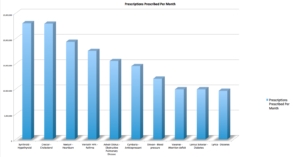Medications can cure infectious diseases, prevent issues from chronic diseases, and minimize pain. On the other hand medications can also result in harmful reactions if not used correctly. Errors can happen in the hospital, at the doctor’s office, at the pharmacy, or at home. Adverse drug events (ADEs) are described as any injuries that are a result from taking a medication. Injuries include physical harm, mental harm, or loss of function. Medication error can be the cause of ADEs and since 2006 the FDA has received over 95,000 reports of medication errors.
A report by Pamela Anderson and Teri Townsend in americannursetoday.com stated:
In 2008, researchers estimated that potentially preventable adverse drug events kill 7,000 Americans annually and that medication errors that result in harm are the num- ber-one cause of inpatient fatalities. While error rates vary widely among facilities, ex- perts believe at least one medication error occurs per hospital patient every day.
Medication errors pose the greatest risks and consequences in critical care set- tings, where patients are sicker and lack the resilience to respond adequately to an adverse event. What’s more, critical care patients typically receive twice as many medications as patients on general floors. Approximately 20% of critical care med- ication errors are potentially life-threatening, and 42% of these errors necessitate additional life-sustaining treatments.
At Home Prescription
At home prescription drug use carries a lot of risk as well and is pervasive across the United States. IMS Health researchers analyzed data on prescriptions and drug sales collected from April 2013 to March 2014. According to the report, the most prescribed drugs are for the following conditions:
http://www.advisory.com/daily-briefing/2014/05/16/the-10-most-prescribed-drugs-in-america
Moreover the CDC shows that adverse drug events are a serious public health problem and estimates that:
-
82% of American adults take at least one medication and 29% take five or more
-
700,000 emergency department visits and 120,000 hospitalizations are due to ADEs annually
-
$3.5 billion is spent on extra medical costs of ADEs annually
-
At least 40% of costs of ambulatory (non-hospital settings) ADEs are estimated to be preventable
Preventing Medication Errors
The CDC predicts that the problem will only grow and so it is important as consumers to be aware of the prevalence of medication errors and do what we can to be informed and safe when taking medications. Be sure to clearly communicate with your doctor and pharmacist. Here are some tips from AHRQ to help better you communication with your health care providers to ensure your safety.
-
Make sure that all of your doctors know about every medicine you are taking.
-
Bring all of your medicines and supplements to your doctor visits.
-
Make sure your doctor knows about any allergies and adverse reactions you have had to medicines.
-
When your doctor writes a prescription for you, make sure you can read it.
-
Ask for information about your medicines in terms you can understand—both when your medicines are prescribed and when you get them.
-
When you pick up your medicine from the pharmacy, ask: Is this the medicine that my doctor prescribed?
-
If you have any questions about the directions on your medicine labels, ask.
-
Ask your pharmacist for the best device to measure your liquid medicine.
- Ask for written information about the side effects your medicine could cause.
